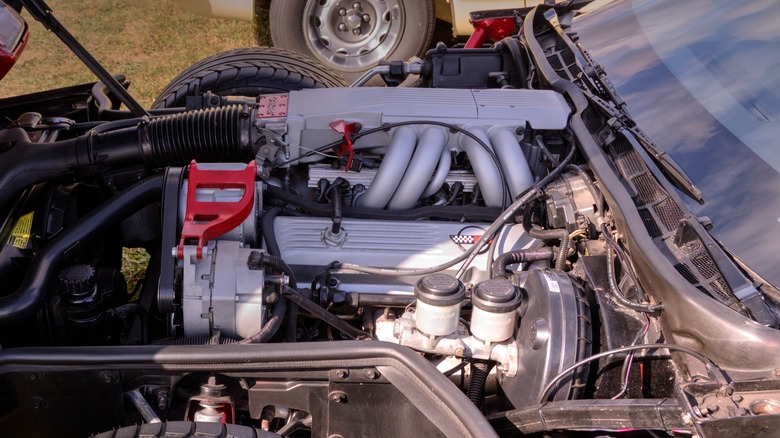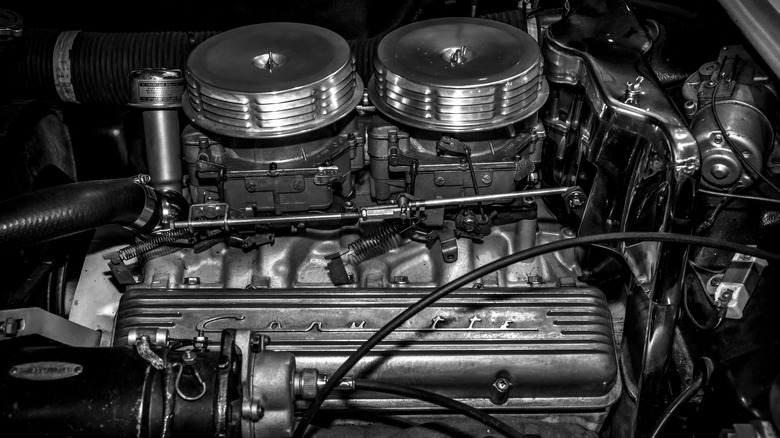The Top 5 Greatest Engines Ever Put In The Corvette, Ranked
When the Chevrolet Corvette debuted in 1953, it wasn't what you would call an instant success. Critics hammered the fledgling Corvette for its shoddy build quality such as plastic side curtains in lieu of window glass and a suspension system that was lifted straight from a sedan. Those quirks may have been forgivable but sports car enthusiasts just couldn't overlook a weak, 150-horsepower "Blue Flame" six-cylinder engine. Fortunately, a passionate engineer named Zora Arkus-Duntov advocated relentlessly for a bigger powerplant and in 1955, the Corvette got its first V8 engine.
If it had not been for the introduction of a V8, the Corvette probably wouldn't have survived its first few years, never mind celebrating its 70th birthday in 2023. So it seems appropriate to reflect on some of the classic and contemporary motors that helped define the 'Vette and propel it into becoming such an enduring piece of Americana.
5. 1985 L98 5.7-liter V8
With the introduction of the all-new fourth-generation C4 Corvette in 1984, Chevrolet made great strides in handling, technology, and comfort versus the aging C3 that it replaced. Unfortunately, it was still paired with Chevy's infamous "cross-fire" throttle body fuel-injected L83 engine that produced just 205 horsepower and 290 pound-feet of torque. To add insult to injury, the L83 was as difficult to maintain as it was gutless, quickly earning the nickname "cease-fire!"
That all changed in 1985 when Chevrolet unveiled its L98 5.7-liter (350 cubic inch) V8. The L98 had a small bump in compression ratio versus the outgoing L83, but the big news was the tuned-port fuel injection setup with its paired intake runners and an individual injector for each cylinder. All of a sudden, the C3's output jumped to 230 horsepower and 330 pound-feet of torque, which was enough to hustle it down a quarter-mile drag strip in the 14-second range, something which hadn't been possible since the early 1970s.
While hardly the most radical engine on this list, the L98 deserves recognition for lifting the Corvette from its Malaise-era doldrums. The L98 remained the Corvette's base engine until it was replaced with the LT1 in 1992.
4. 1971 LS6 454 cubic inch V8
The 1971 Corvette C3 with the optional LS6 engine is one of the rarest Corvettes ever. It was only offered for one year and only 188 were made. Rated at 425 horsepower and 475 pound-feet of torque, it was the swan song of the big block engines in Chevy's sport car. Sure, the big block 454 (7.4 liters) would continue to be offered through 1974, but lower compression ratios and emissions equipment would strangle this engine with less horsepower every consecutive year.
Interestingly, the 1971 version of the LS6 differs from the 1970 iteration, which was exclusive to the Chevelle and El Camino. The 1971 Corvette LS6 had a lower compression ratio to better prepare for the takeover of unleaded gasoline at the pumps, but this potential negative was offset by a set of efficient aluminum cylinder heads, versus steel on the 1970 motor.
The LS6 was said to be underrated from the factory, especially if some freer-flowing tubular exhaust manifolds (a.k.a., "headers") were fitted. In stock form, Car and Driver ran one down the quarter-mile in 13.8 seconds and hit 140 mph in the Nevada desert, an impressive feat for 50-plus years ago.
[Above image by Sicnag via Wikimedia Commons | Cropped and scaled | CC BY 2.0]
3. 1957 283 cubic inch V8
Though the first V8 engine showed up in the Corvette as an option in 1955, that 265 cubic-inch powerplant was an improvement over the standard six cylinder, but still somewhat anemic. That would change in 1957 with the introduction of the 283 cubic-inch V8. The 283 (4.6 liters) was available in a multitude of different horsepower levels and induction options, including a single 4-barrel carburetor, dual 4-barrel carbs, or the new "Ramjet" fuel-injection setup.
In fact, the 1957 Corvette was the first American production car ever to feature fuel injection. The hottest variant of the 283 "fuelie" produced 283 horsepower, which equated to one horsepower per cubic inch, an accomplishment that was unheard of for a performance car at the time. Besides fuel injection, the 1957 Corvette also premiered a transmission with four forward speeds, a rarity outside of European sports cars. Road & Track drove one from zero to 60 mph in 5.7 seconds and covered the standing start quarter-mile in 14.3 seconds. That was literally race car performance in 1957.
2. 1969 ZL1 427 cubic inch V8
The 1969 Corvette C3 with a ZL1 engine is the holy grail for Corvette collectors. Only two — yes two — were ever sold to the public, one of which fetched $3.14 million at the 25th Annual RM Sothebys auction in January 2023. What the heck is a ZL1? It's an all-aluminum version of Chevy's famous L88-code 427 cubic-inch big-block engine (pictured above) that debuted in 1967. The L88 was really meant for customers who intended to turn their Corvettes into race cars and ordering one for regular street driving was highly discouraged by Chevrolet and its network of dealerships.
The ZL1's aluminum components meant shedding the extra weight of an iron block and cylinder heads from the nose of the Corvette, which improved balance and the overall power-to-weight ratio. Unfortunately, the ZL1 option cost an additional $4,700, which almost doubled the 1969 Corvette's base price of $4,781. Hence, the reason why so few were purchased.
Chevy advertised 430 horsepower for the ZL1, but these engines were widely rumored to make closer to 500 horsepower in reality. Back in the day, Road & Track magazine drove a prototype from zero to 60 mph in 4.0 seconds and recorded a quarter-mile time of 12.1 seconds at 116 mph.
1. 2023 LT6 5.5 Liter V8
Exclusively available in the C8 Corvette Z06, Chevy's new LT6 powerplant is rated 670 horsepower at a dizzying 8400 rpm. Peak torque comes in at 460 pound-feet at 6300 rpm, which is almost the redline for a regular C8 Stingray. The end result is a rocket that can accelerate from zero to 60 mph in only 2.6 seconds. How does a relatively large V8 rev so high? It has a lightweight, flat-plane crankshaft which eliminates the need for large counterweights found with traditional crankshafts.
What's more, some early dyno tests by lucky Z06 owners seem to indicate that Chevy may have actually underrated the LT6. Automotive YouTuber Speed Phenom's Corvette Z06 laid down 610 horsepower on the chassis dyno at Dallas Performance in Dallas, Texas. Typically, parasitic load from a vehicle's drivetrain robs about 15% of the horsepower as measured at the crankshaft. So to end up at 610 horsepower on a chassis dyno, the true output at the crankshaft is likely in the neighborhood of 700 horsepower. All in a package that's tame enough to be your daily driver.





